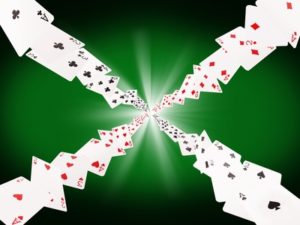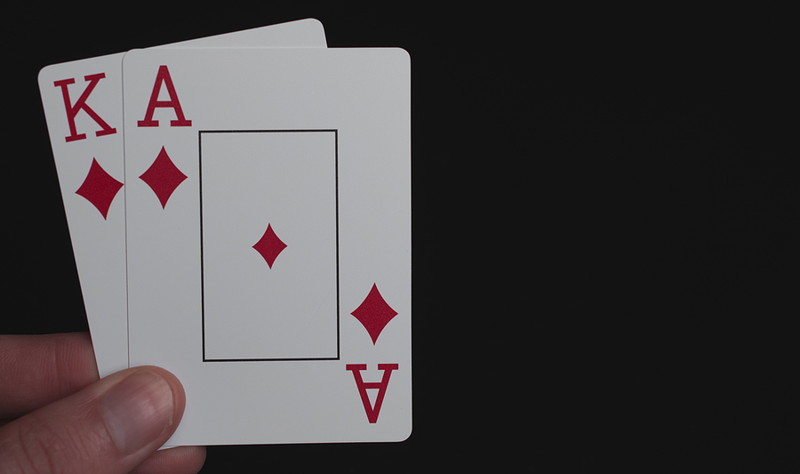 Blackjack is a traditional game where those skilled in optimal strategy and card counting achieve positive results in the long run. It is a game where a decision is required after every card dealt to your hand.
Blackjack is a traditional game where those skilled in optimal strategy and card counting achieve positive results in the long run. It is a game where a decision is required after every card dealt to your hand.
Optimal strategies in blackjack are expectation-based, that is, every optimal action is chosen to maximize expected value and as such is not based on odds only. The optimal strategies in blackjack are expressed in ready-to-use forms as the well-known strategy charts (basic strategy and card-counting strategy). An expectation-based strategy can only be effective in the long run.
For players who do not play constantly or have difficulty in memorising the strategy charts or applying them, using the estimated odds in their decisions is an objective option. However, estimating odds in a quick time during the game is not a skill at everybody’s hand and requires special cognitive and math skills.
In this article we will see what kind of odds can be estimated during the game of blackjack and what the basic techniques are available for such estimation.
Types of odds in blackjack
 The odds tables available for blackjack from expert sources list some “idealised” odds for every possible situation (the probability that you beat the dealer for any total of your hand and any dealer’s first card), in the sense that they do not take into account the specific cards dealt, but just the totals.
The odds tables available for blackjack from expert sources list some “idealised” odds for every possible situation (the probability that you beat the dealer for any total of your hand and any dealer’s first card), in the sense that they do not take into account the specific cards dealt, but just the totals.
They apply to the game where cards are dealt from a shoe with a stack, which assumes a sample space associated with an infinite deck of cards (where every card value less than 10 has the probability 1/13 and those valued 10 have the probability 4/13). Having them memorised before the game is good information to use, however in certain configurations the real odds (based on available information) may differ significantly from the idealised ones.
In blackjack there are several types of odds and most of them are conditional, requiring two-step computations based on relatively complicated formulas.
There are immediate odds, associated to events defined with the next card to come (for instance, achieving a certain total for your hand with one forthcoming card), and long-shot odds, associated to events defined with two or more cards to come (for instance, the odds that you will beat the dealer with your current total).
The only types of odds that may be estimated during the game by the mathematically skilled players are the immediate odds or odds for the next two cards to come (this latter type for highly skilled players).
Immediate odds in blackjack
 These are probabilities for the next card to come to have a certain value and can be computed by the player simply by doing a minimal count, two subtractions and a division. The count is for the so-called ‘outs’, that is, the cards remained in play of a certain favourable value or values.
These are probabilities for the next card to come to have a certain value and can be computed by the player simply by doing a minimal count, two subtractions and a division. The count is for the so-called ‘outs’, that is, the cards remained in play of a certain favourable value or values.
By applying the classical formula of probability P(E) = n/m, where n is the number of favourable situations for the event E to occur and m the number of all equally-possible situations, we can find the immediate odds by dividing the number of outs to the number of all possible cards.
Example:
In two-deck blackjack, you are the first player and you were dealt 7, 8, A, dealer’s face-up card is 9 and you want the probability of getting a total of 19 to 21 with the next card.
This probability is computed as follows: A favourable card for the target event should have value 3, 4 or 5. There are 3 × 8 = 24 such cards and none of them is dealt, so they are all in the remaining cards, numbering 104 – 4 = 100. The sought probability is then 24/100 = 1/4.16. About 1 in 4.
The general formula for such computation is:
Denote by p(x) is the probability of a card with value x being drawn as the next card, by d the number of decks used, by k(x) the number of x-valued cards already dealt, and by N the total number of cards already dealt, then
p(x) = [4d – k(x)]/(52d – N), if x is different from 10 and
p(x) = [16d – k(x)]/(52d – N), if x is 10.
If you formulate your target event as a disjunction of multiple values (any of them being favourable), like in the example above, you have to apply the formula for each of those values, then add the results together.
Although it’s simple arithmetic, doing the count and all these operations in mind in a short time (especially the division) is not at everybody’s hand, but is trainable.
Long-shot odds in blackjack

If you want to find the probability that you will win the round in a given card configuration, there is no option except to know this probability in advance, from an odds table. We are talking about conditional combinatorial probabilities, which are the most difficult to compute (on the paper, not mentioning in mind).
Of course, such probabilities change with every new card dealt and each particular card configuration changes the apriori probability. For evaluating your chances in a given moment basing on the current card distribution, the most you can do in mind is to estimate your odds of achieving certain totals with at most two cards to come (anyway, the most frequent size of a final hand is of 2 – 3 cards).
Your estimation assumes to find first the immediate odds of achieving the target total (with one card to come), then add the odds of achieving it with two cards to come. The latter probability is more difficult to compute than the latter, as we face the combinatorial nature of the game.
Example:
Let’s keep the same assumption as in the previous example and compute the odds for a total of 19 to 21 to be achieved with two cards to come:
First, establish your m (in the probability fraction). There are 104 – 4 = 100 unknown cards, of which any combination of two cards is possible. Then, m = C(100,2) = (99 x 100)/2 = 99 x 50 = 4,950.
Now, finding the n:
For achieving 19 points, a total of 3 points from the next two cards is necessary. The favorable combinations are (2A). For counting them, we should count first the outs: there are eight 2s and seven aces left, so the number of possible (2A) combinations is 8 x 7 = 56.
For 20 points, a total of 4 forthcoming points is necessary, implying the favorable combinations (22) and (3A). There are eight 2s, eight 3s, and seven aces left. The total number of combinations (22) and (3A) is C(8,2) + 8 x 7 = 28 + 56 = 84.
Finally, for 21 points, a total of 5 forthcoming points is necessary, and the favorable combinations for that are (32) and (4A), in number of 8 x 8 + 8 x 7 = 64 + 56 = 120.
In total, there are n = 56 + 84 + 120 = 260 favorable combinations and the sought probability is P = n/m= 260/4,950 = 1/19.03. About 1 in 19. It’s a low one, however we have to add the previous immediate odds for having the real probability of the target event: 1/19 + 1/4.
Obviously, an average individual cannot perform these latter computations in mind during the game and only a gifted one could do that. It’s far more difficult than keeping the current or true count in the card-counting strategy. But if we compare the above results in our examples, we can see than the immediate odds are far higher than the long-shot odds and as such the latter could be ignored.
One can stay with 1/4 as the odds for the target event, as an approximation. Such a technique of estimating odds is called ‘selecting the dominant probabilities’. Yet such situation is particular and it can happen for the long-shot odds to count more in the total sum.
Conclusion
Doing a quick estimation for the immediate odds in blackjack is a feasible task for those computationally inclined, however estimating long-shot odds is really for the gifted ones and sometimes does not worth the effort.
Doing your lessons by memorising the classical odds tables before the game remains the wise action, but those skilled can train the quick estimations during the game for gaining advantage.
About The Author
The author of this page is Dr. Catalin Barboianu. Catalin is a mathematician specialising in gaming and responsible gambling and a research associate at the University of Bucharest.
